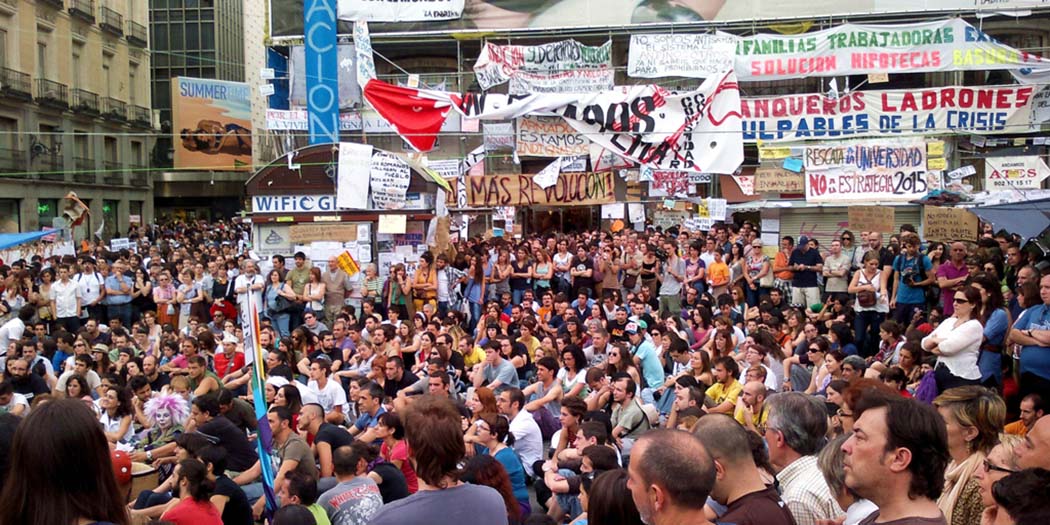What are the differences and similarities between the Arab Spring revolution and the January 2021 assault on the Capitol?
In January 2021, a mob forced their way into the US Congress in an attempt to stop the inauguration of the president-elect Joe Biden. There was music, and people with Hawaiian shirts, orange caps, Pepe the Frog masks, and South Vietnamese flags. There was a chanting shaman in a bison-fur headdress, and stands with drinks, patches and T-shirts showing slogans like “Trust the Plan”, “Save the Children”, and the letters Q, MAGA, and WWG1WGA. The atmosphere was buoyant; the makeup festive. It looked more like a rave than a protest or a coup.
One of the many videos of the assault shows a group of armed civilians in combat gear entering the Capitol, communicating via walkie-talkies. They talk about hanging Vice-President Mike Pence because he didn’t block the congressional session certifying Joe Biden as the winner of the election. They accuse him of treason, they discuss the media coverage of the assault, and they bid each other fond farewells: “take care; may God bless you”. A man in a yellow vest goes in and walks around, waving the flag of the Confederate States of America, which was made up of the seven secessionist slave states that fought against abolition in the Civil War.
Ten years earlier, a crowd of 15,000 people gathered in Liberation Square, Tahrir Square, in the heart of Cairo, after a rallying call by a coalition of civil movements, students’ associations, human rights activists, civic centres and football clubs. They weren’t out to get anyone, nor were they carrying any weapons. They were there to call for the resignation of the Minister of the Interior and demand an end to the permanent state of emergency, as well as a presidential limit that would put an end to the regime of Hosni Mubarak. Over the next five days, the demonstration grew by tens of thousands, and the Egyptian security forces came down on them with rubber bullets, water cannons, tear gas, and 151-dB sonic weapons that can permanently perforate an ear drum and cause temporary blindness. The demonstrators defended themselves with bricks and stones. On the last day of January there were 250,000 demonstrators in the square; on the first day of February there were a million. Ten days later, vice-president Omar Suleiman announced that Mubarak had handed over power to the armed forces.
In the ten years between the Arab Spring and the storming of the US Capitol, the democratic wave has turned around. History tends to work like this. The response to these mass movements, as manifested in parties like Podemos in Spain and Syriza in Greece, was the rise of other movements that would support Donald Trump in the United States, Jair Bolsonaro in Brazil, Narendra Modi in India, and Viktor Orbán in Hungary. Fear has switched sides again, and the revolution has a new battlefield. It’s left the squares and streets behind, moving onto the social network instead.
The social network is as different from the public square as the assault on the Capitol is from the protests in Tahrir Square. In 1968, John Berger wrote that “a mass demonstration distinguishes itself from other mass crowds because it congregates in public to create its function, instead of forming in response to one”. Unlike a strike or a rave, a demonstration is “an assembly which challenges what is given by the mere fact of its coming together.” The stark facts that brought the people in Egypt together were their everyday shared reality of the dictatorship, i.e. hunger, unemployment and violence. The purpose of the assault on the Capitol was premeditated, and it had been constructed upon a host of interrelated fictions, all created with one and the same intention: they claimed that coronavirus doesn’t exist, that the election was rigged by a network of powerful, satanic, paedophilic and cannibalistic Democrats, and that Donald Trump is a lone hero fighting to “drain the swamp” in order to protect children and save the nation. These stories were created and propagated en masse and under the radar, in campaigns not broadcast on radio or television. They were invisible to all the other citizens and the authorities, but very much visible and profitable for Facebook, their main channel.
The Arab Spring wasn’t planned on Facebook. The assault on the Capitol was. Not on the dark web or “special” platforms like Parler, Gab, and Voat, or on “special” forums like 4Chan or 8kun, but on two huge global platforms: Facebook and YouTube. They pump out enough disinformation to convince decent folk to ditch their masks, stop vaccinating their kids, and take their gun to the local pizzeria; the kind of disinformation that prompts the mentally disturbed to kill dozens of strangers in a synagogue, college, or club. These are two information monocultures where fear thrives in the shadows, channelled by political opportunism and duly coming to the surface in the form of collective violence.
But they do have something in common. The triumphant photos and videos published by the Capitol assailants have been scrutinised by the authorities to identify as many of them as possible, just as the new regimes would invariably detain revolutionary leaders and make them disappear. Also, they are similar insomuch they both failed, but only just. Ten years ago, we overestimated the fragility of authoritarianism, wishfully hoping that the tools of globalisation and the unstoppable march of history would be sufficient to quash it. On 6th January 2021, the day of the Capitol assault, we learned that democracy, too, is fragile. And that the nihilist opportunism that prevails in the latest version of capitalism could well be enough to destroy it.
Ten years ago, the integration of the Arab world into a global market, marked by mass access to telecommunications, pitted democratic virtues against the regime. Today, the economic crisis, financial opportunism and the pandemic have condemned many of those who are plotting the next assault to perpetual unemployment: their fear and humiliation makes them easy prey for false news stories, dark campaigns and the lies of leaders like Trump. This explains how the class struggle in America brought about the right circumstances and conditions to allow such a mediocre and grotesque man to become a hero. Two generations of American workers lost their jobs in the economic crisis, in a country that abandons and dehumanises the unemployed.
All of this could change. The same structures that cast a spell on the collective imagination could also be turned on their head, to provide comfort and support instead of hatred, fear, and self-destruction. But, as always, someone will have to pay the price. Facebook is not and never will be a public square. Rather, it’s a simulation of a shopping mall. The square is where your neighbours are; that’s your real community.




